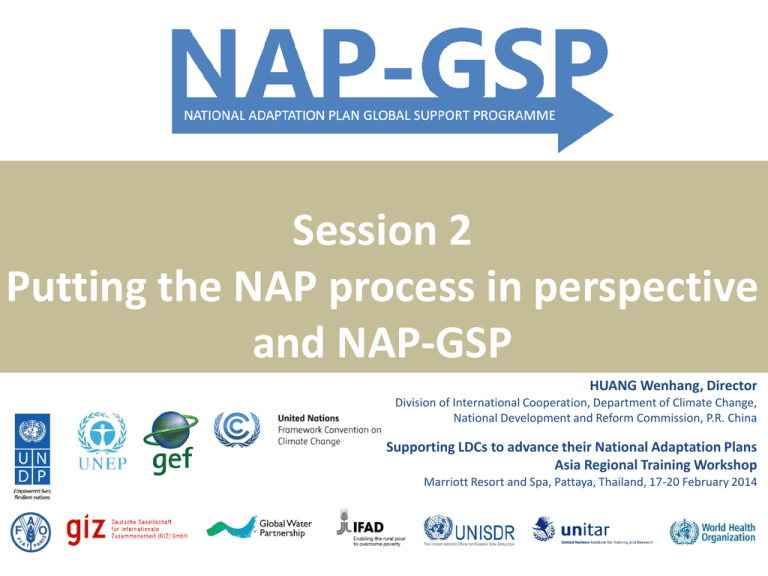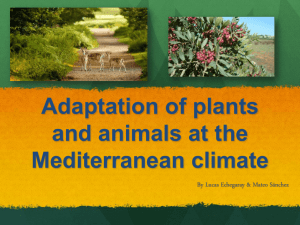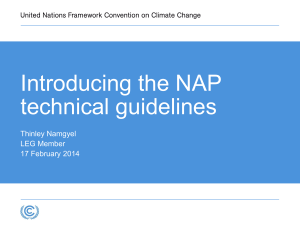China experience on stakeholder engagement for - UNDP-ALM
advertisement

Session 2 Putting the NAP process in perspective and NAP-GSP HUANG Wenhang, Director Division of International Cooperation, Department of Climate Change, National Development and Reform Commission, P.R. China Supporting LDCs to advance their National Adaptation Plans Asia Regional Training Workshop Marriott Resort and Spa, Pattaya, Thailand, 17-20 February 2014 China experience on stakeholder engagement for formulating adaptation plan 1. Institution Arrangement 2. Policies & Strategy 3. Way forward Session 2 Putting the NAP process in perspective and NAP-GSP Supporting LDCs to advance their National Adaptation Plans Asia Regional Training Workshop 1. Institution Arrangement • Governing Bodies: – Special unit to deal with climate change set up in 1990; – National Coordination Committee on Climate Change (NCCCC) established in 1998; – National Panel on Climate Change set up in 2006; – National Leading Group to Address Climate Change set up in 2007; – Climate Change Department established in NDRC to undertake the general work in respect of climate change in 2008; – A liaison office was set up for the National Leading Group in 2010 Session 2 Putting the NAP process in perspective and NAP-GSP Supporting LDCs to advance their National Adaptation Plans Asia Regional Training Workshop China’s National Leading Group on Climate Change Composition: Ministry of Foreign Affaires National Development and Reform Commission Ministry of Science and Technology Ministry of Industry and Information Technology Ministry of Finance Ministry of Land and Resources Ministry of Environmental Protection Ministry of Housing and Urban-Rural Development Ministry of Transport Ministry of Water Resources Ministry of Agriculture Ministry of Commerce Ministry of Health National Bureau of Statistics State Forestry Administration Chinese Academy of Sciences China Meteorological Administration National Energy Administration China Civil Aviation Administration State Oceanic Administration Provincial Leading Group on Climate Change Composition: Provincial Development and Reform Committee (PDRC); Provincial Finance Department Office of Leading Group on Climate Change: Hosted by PDRC National Leading Group on Climate Change Office: hosted by NDRC Implementation Unit: Department of Climate Change, NDRC 1. Institution Arrangement • Science & Technology: – NDRC, MOST, NSFC and the National Leading Group are playing a key role in setting priorities for state investment on S&T. – Research infrastructures such as large-scale observation networks have been put in place. • • • • national climate monitoring network national weather observation network national specialized meteorological observation network national ecological observation network (backboned by the CERN of CAS) and CO2 flux observation network (backboned by the ChinaFLUX of CAS) – Research institutions such as the CAS, the CAAS, CMA and many state universities have set up core teams of over 1000 research scientists. Session 2 Putting the NAP process in perspective and NAP-GSP Supporting LDCs to advance their National Adaptation Plans Asia Regional Training Workshop China’s Technologies on CCA CERN: demonstration on CCA 中国生态系统研究网络的适 应技术示范 Desertification control 防治沙漠化 Loess Plateau 黄土高原 Algae removal 除藻 Applicable Technology Manual for SSC on S&T to Address Climate Change (2nd Edition, 2011) 《南南科技合作应对气候变化适用 技术手册》(第二版, 2011年) Drought-resistant seedling plantation 抗旱苗木种植 Desert shrub breeding 荒漠区灌木 繁育 Solar energybased irrigation 太阳能灌溉 Coastal mangrove restoration 沿海红树林恢复 1. Institution Arrangement • Education, Outreach and Public Awareness: – incorporated into the framework of basic education, adult education and higher education; – fully using the mass media such as books, newspapers, periodicals, audio and video products Session 2 Putting the NAP process in perspective and NAP-GSP Supporting LDCs to advance their National Adaptation Plans Asia Regional Training Workshop Outreach Institutions on Climate Change in China Type Media Institution • CCTV; Xinhua News Agency; other media • CMA; CMP • Department of Climate Change under NDRC; • MOST; Science Press Meetings • NDRC; MOFA; MOST; CMA • Tianjin Municipal Government Thematic • China (Beijing) International Energy Saving and Environment Protection outreach Exhibition (BIESEPE) • Beijing 2008 Olympic Games • World Expo 2010 Shanghai • The 20th National Book Expo in 2010 • World Environment Day, World Meteorological Day, World Earth Day, Science Day NGOs • Friends of Nature, Global Village – Beijing, Green Earth Volunteers, etc • China Youth Climate Action Network (CYCAN) • WWF 1. Institution Arrangement • International Cooperation: Ministry Programmes NDRC South-South Cooperation Programme on Climate Change, 2011-2013; Adapting to Climate Change in China (ACCC) project, 2009-2013; GEF-SCCF project “Enhancing Capacity, Knowledge and Technology Support to Build Climate Resilience of Vulnerable Developing Countries”, 2013-2017 MOST Science and Technology Partnership Programme with other developing countries; International S&T Cooperation Network/Platform (http://www.actc.org.cn); Applicable Technology Manuals for SSC on S&T to Address Climate Change NSFC International Young Scientist Research Fund CAS Specially Hired Foreign Research Fellows Project; Youth Foreign Scientist Project; UNEP-IEMP; MOC, MOA, SFA, MWR, MEP, etc Foreign aid programme, including technological cooperation programmes and human resources development programmes China’s SSC Programme on Climate Change (SSCP) • The 12th Five-Year Plan – “will provide help and support to developing countries on climate change” • • • COP17, 2011, announced by Mr. XIE Zhenhua, Vice Chairman of NDRC USD 31.7 million, 12 countries from 2011-2013 Post 2013, China to continue supporting SSCP Adapting to Climate Change in China (ACCC) • ACCC is major China – UK – Swiss climate change adaptation research/policy project which aims to: – – – – Developing accurate regional/national climate models Assessing impacts, vulnerability and risk Mainstreaming adaptation into development planning …. SDC to support second phase including S-S Coop (others welcome to join) North and northeast: Northwest: Desertification (higher evaporation) Increased water scarcity Coastal regions: Typhoons, storm surge and long-term inundation Southern China: Increase in flood frequency and magnitude; northwards spread of “tropical” disease vectors Tibetan Plateau: Change in river flows / melting glaciers ACCC Pilot Provinces GEF-SCCF EBA project Project title Enhancing Capacity, Knowledge and Technology Support to Build Climate Resilience of Vulnerable Developing Countries Geographical scope Global: Africa and Asia-Pacific Project executing organisation National Development and Reform Commission (NDRC) 2. Policies & Strategy • Comprehensive Policies: – Initial and Second National Communication on Climate Change (2004); Second National Assessment Report on Climate Change (2012); – First National Assessment Report on Climate Change(2006); Second National Assessment Report on Climate Change (2011) – China's National Climate Change Programme (June 3 2007); – China's Scientific & Technological Actions on Climate Change (June 14 2007); – China’s Policies and Actions for Addressing Climate Change (first issued on October 29 2008 and then annually ); – Implementation of the Bali Road Map – China’s Position on the Copenhagen Climate Change Conference (May 20 2009); – Outline of the Twelfth Five-Year Plan for National Economic and Social Development (March 2011) Session 2 Putting the NAP process in perspective and NAP-GSP Supporting LDCs to advance their National Adaptation Plans Asia Regional Training Workshop 2. Policies & Strategy • Measures for enhancing adaptation capacity during the 12th Five-Year: – To study and formulate policies and measures allowing agriculture and forestry to respond to climate change, and guaranteeing food and ecological safety; – To rationally tap and optimize the allocation of water resources, and strengthen various water-saving policies and measures; – To enhance monitoring and protection of marine and coastal ecosystems, and increase the coastal areas’ capacity to resist marine disasters; – To improve the emergency-response system, starting mechanism and multi-disaster early warning mechanism to tackle extreme meteorological disasters. Session 2 Putting the NAP process in perspective and NAP-GSP Supporting LDCs to advance their National Adaptation Plans Asia Regional Training Workshop Sustainable Forestry Management: China has done a great job in preventing illegal logging and recovering its forest resources through increasing public awareness of forestry and environmental protection and deepening forestry reforms. Session 2 Putting the NAP process in perspective and NAP-GSP Supporting LDCs to advance their National Adaptation Plans Asia Regional Training Workshop Returning Farmland to Forests: The people's governments at all levels shall strictly implement the policies and measures of "converting farmland to forests, closing mountains for greening, providing grain as relief and making contracts with individuals." Session 2 Putting the NAP process in perspective and NAP-GSP Supporting LDCs to advance their National Adaptation Plans Asia Regional Training Workshop Return Grazing Land to Grassland: Improve policies for returning grazing land to grassland, quicken the implementation and expand of the coverage of the said project, enhance efforts on building human-made pasture, water complex in pasturing areas and livestock sheds, and promote breeding of livestock according to natural conditions and in sheds. Session 2 Putting the NAP process in perspective and NAP-GSP Supporting LDCs to advance their National Adaptation Plans Asia Regional Training Workshop 2. Policies & Strategy • National Climate Change Adaptation Strategy: – During 2011-2013, NDRC has developed a national strategy for climate change adaptation. – The strategy, based on the assessment of the impact of climate change on China’s economic and social development, has laid out clear guidelines and principles for climate change adaptation, as well as proposed adaptation objectives, major tasks, regional patterns and safeguarding measures. – Provinces, including Zhejiang, Henan and Liaoning, have carried out their own regional strategic studies for addressing climate change. Session 2 Putting the NAP process in perspective and NAP-GSP Study on National Strategy of Climate Change Adaptation (2011) Supporting LDCs to advance their National Adaptation Plans Asia Regional Training Workshop 4. Way forward • SSC: – how to further China’s SSC Programme with more attention EBA? • NAP: – how China can advance her NAP processes to meet the needs identified, with tech. support from int’l community? Session 2 Putting the NAP process in perspective and NAP-GSP Supporting LDCs to advance their National Adaptation Plans Asia Regional Training Workshop [Session number] [Session title] Supporting LDCs to advance their National Adaptation Plans Asia Regional Training Workshop










